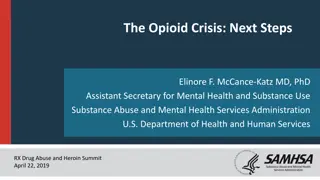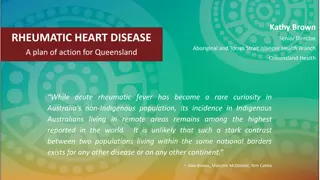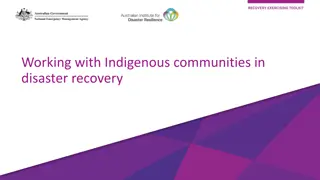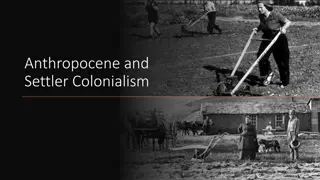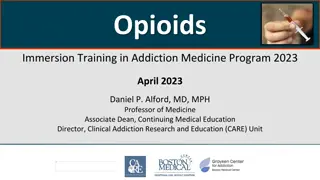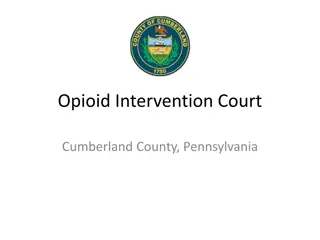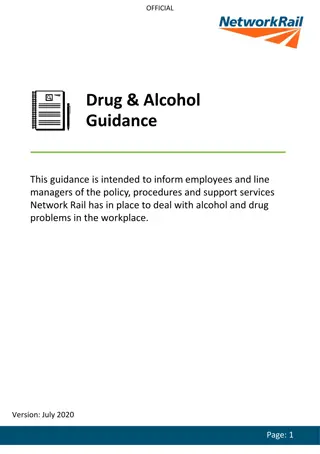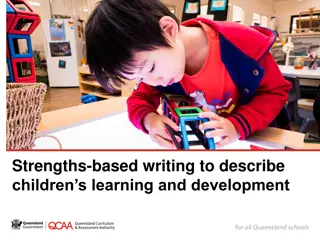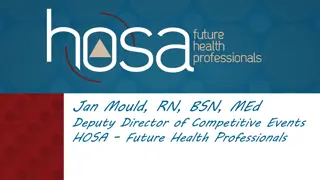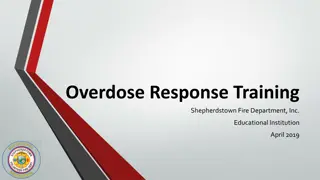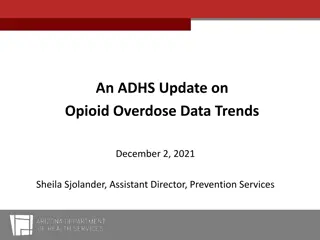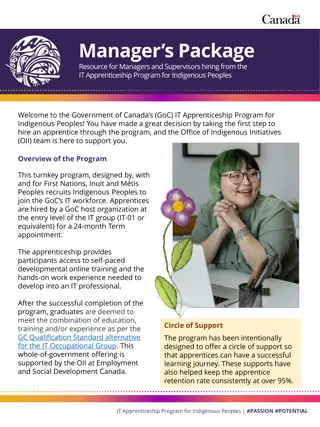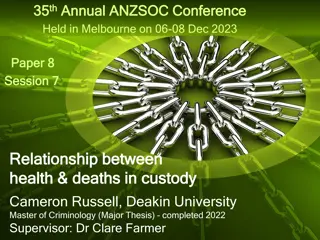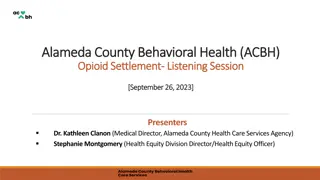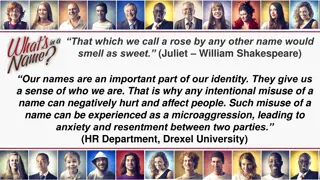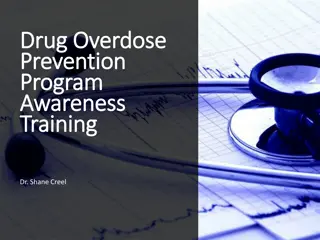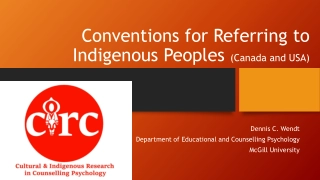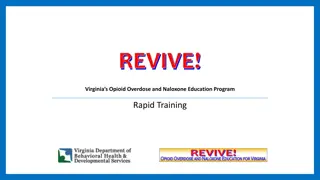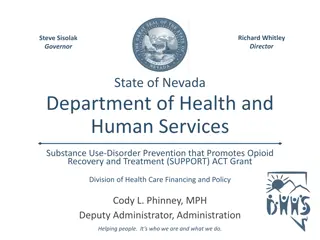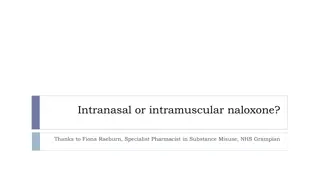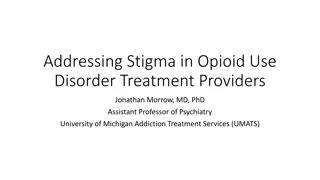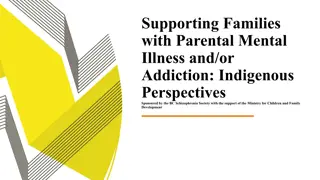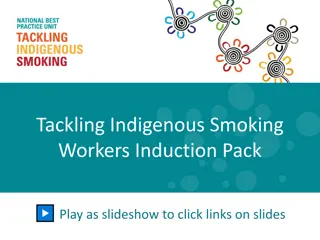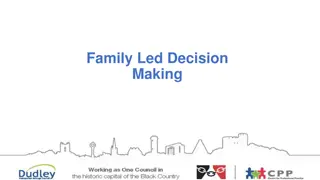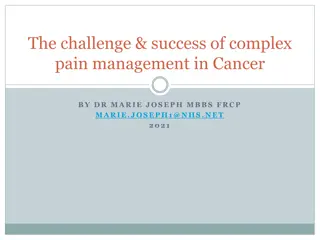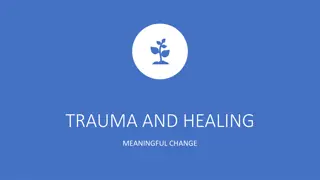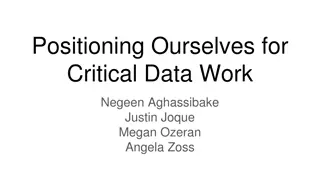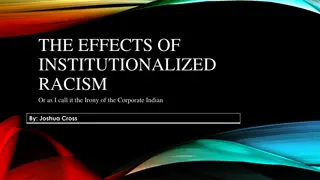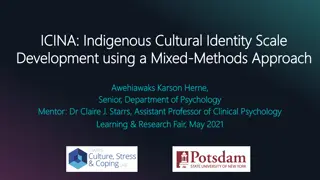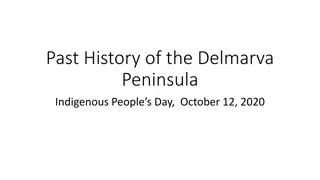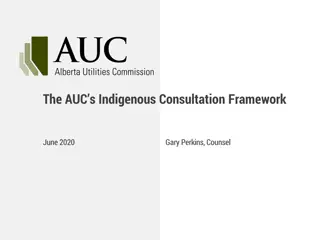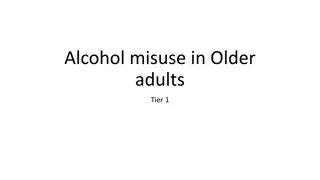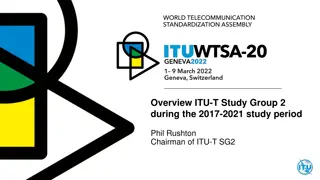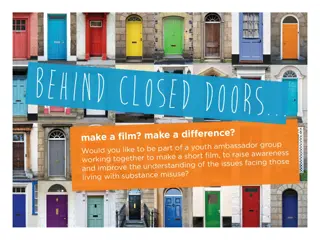Indigenous and Strengths-Based Approaches in Addressing Opioid Misuse
Explore the application of Indigenous and strengths-based approaches to tackle opioid misuse, focusing on harm reduction, intervention models, key concepts of HIV and HCV transmission, and value systems that guide work in communities. Gain insights into the value systems shaping attitudes towards substance use and learn how understanding personal values can strengthen relationships and resilience in challenging situations.
Download Presentation

Please find below an Image/Link to download the presentation.
The content on the website is provided AS IS for your information and personal use only. It may not be sold, licensed, or shared on other websites without obtaining consent from the author. Download presentation by click this link. If you encounter any issues during the download, it is possible that the publisher has removed the file from their server.
E N D
Presentation Transcript
INDIGENOUS AND STRENGTHS-BASED APPROACHES TO ADDRESS OPIOID MISUSE Matt Ignacio (Tohono O odham), PhC, MSSW CSWE MFP Fellow Doctoral Candidate School of Social Work University of Washington
Discussion Points: Value Systems Overview of Harm Reduction Harm Reduction Intervention Models Addressing Opioid Use in Community
Key Concepts: HIV Transmission HIV Risk (a continuum) Sex -unprotected anal and vaginal intercourse; Mother to child -pregnancy, birth or breast feeding; Syringes -sharing syringes, not cleaning used syringes to inject substances.
Key Concepts: HCV Transmission Viral Hepatitis Transmission: Hepatitis A: Ingestion of fecal matter, sexual contact, contaminated food and drink; Hepatitis B: Contact with infectious blood, semen or other fluids, sexual contact, sharing injection equipment, needle sticks; Hepatitis C: Contact with infectious blood primarily through sharing syringes AND other injection equipment.
What values guide your work? What value systems do you rely on?
What Values Guide Your Work? Understanding our values can: Keep us grounded, focused in the work. Help create foundation for all relationships (at work and otherwise). Fall back on when we encounter challenges.
Value Systems: Exploring our values typically occurs on 3 levels: 1) External factors: Examples: our parents, families, friends, and media. 2) Personal experiences: Examples: our first sexual encounter, first time we experimented with drugs, any history of abuse and assault, and our attitudes about what s acceptable and not.
Value Systems: 3) Obligations as Providers: Examples: Organizational goals, mission statement, policies and procedures, job role, and job expectations.
Value Systems: I would include, for Native populations, there is a 4th level: 4) Role of our cultural and traditional values, original instructions Inherent part of our existence Tribal specific code of values and ethics Grounded in our collective experience, evidence-based Divine gift -Rooted in spirituality Live in balance with the universe
Example: Tohono Oodham Himdag: The Tohono O'odham Himdag consists of the culture, way of life, and values that are uniquely held and displayed by the Tohono O odham people. Himdag incorporates everything in life that makes us unique as individuals and as a people. It is a lifelong journey. Arts (basketry, contemporary and traditional music etc.) Community (Tohono O'odham Community College, Tohono O'odham Nation, Family) Games Beliefs Harvesting, traditional foods and hunting Language Land, environment, seas (incorporates songs and ceremonies) Seasons (Winter, spring, summer, fall) and elements (Earth, air, fire, wind) Medicinal plants Mobility (Walking, running, horses, and wagons) Past, future, a journey in life Relatives (Ak-Chin, Akimel, and HiaCedO'odham, Kinship) Songs Storytelling Spirituality/Religion (Healing, curing and traditional songs) Sensitivity Values (respect) https://www.tocc.edu/himdag-committee
OVERVIEW OF HARM REDUCTION
Historical Approaches to Addressing Drug Use: Locating the problem in the person, not the substance (Solution: moral approach, criminal justice model, demand reduction) Locating the problem in the substance, not the person (Solution: war on drugs , supply reduction, boarder patrol) Harm reduction movement: Locates the problem in the relationship between the person and the substance, which may change over time.
Harm Reduction: Definition: Harm Reduction is a perspective and a set of practical strategies to reduce the negative consequences of drug use, incorporating a spectrum of strategies from safer use to abstinence. One historical context: public health policy in Western Europe out of the epidemics of Hepatitis and HIV.
Harm Reduction: Cessation of drug use does not have to be the first goal of intervention. Abstinence is an excellent form of harm reduction if the client wants to stop using drugs. Many clients have not made a decision to stop or may state they wish to continue to use drugs, but still need assistance. Service providers meet clients where they are, not where we would like them to be.
Harm Reduction: Ensures that drug users and those with a history of drug use routinely have a real voice in the creation of programs and policies designed to serve them. Affirms drug users themselves as the primary agents of reducing drug-related harm and seeks to empower users to share information and support each other in strategies which meet their actual needs.
Harm Reduction: Recognizes that the realities of poverty, class, racism, social isolation, past trauma, sex-based discrimination and other social inequalities affect both people's vulnerability to and capacity for effectively dealing with drug-related harm. Does not attempt to minimize or ignore the real and tragic harm and danger associated with drug use.
Native Values AND Harm Reduction: How I guide my work Giving Back by Sharing What We Know We, as Native people, have a responsibility to educate ourselves, and share the information with those in our family and community. Education/outreach
Native Values AND Harm Reduction: Cultural Value of Respecting All Life A person who injects drugs is someone s mother, father, sister, daughter, son, and friend. We can be effective helpers when we set aside our own judgments and see the person for who they are a human being. Meeting the client where they are at and providing non- judgemental services
Native Values AND Harm Reduction: Cultural Value of Helping Others IDUs can be stigmatized, judged, vilified, demonized, and ignored; yet they are part of our family, they are part of the circle. It is our responsibility to care for and help our own people, including those who inject drugs. Compassionate responses to drug users and drug-related harm
Native Values AND Harm Reduction: Cultural Value of Compassion Defined as: to suffer together. The feelings you have when witnessing someone s suffering and feel motivated to help. Similarly, empathy, is the ability to understand someone s suffering from their perspective. However, compassion includes the desire to help.
Key Concepts: Cultural Values When we educate ourselves on the health needs of those who use drugs and respond compassionately - we honor our traditions of sharing what we know, helping others and respecting all life.
Continuum of Use Experimental Social and ritual use Intermittent use Regular use Binge use Abuse Dependence Severely and persistently chemically dependent; chronic relapse
What is Injection Drug Use? HIV and Hepatitis C (HCV) can be transmitted very easily via injecting and sharing syringe. Trace amounts of blood can enter the syringe and remain in the barrel. Environment is ideal for the virus to remain alive for a period of time largely because of the hermetic seal.
IDU Harms: Forgetting to take medications: active users may forget to take medications regularly. Dependency/disorders: characterized by continued, on-going use despite the problems that are produced. Track marks: injecting drugs directly into the vein can cause darkening of the veins due to scarring and toxin buildup.
IDU Harms: Stigma: Stigma and shame can be experienced from strangers, family, friends, and co-workers. Furthermore, social service, health care and drug treatment providers may also stigmatize IDUs. Isolation: Because of stigma and discrimination IDUs are often an invisible population. Rejection, marginalization, and isolation from the larger community, can exacerbate drug use and dependency. Compromised cultural values: Using substances outside of Native ceremonial or religious purposes may be viewed as bad or disrespectful, so known users may not be welcome.
HARM REDUCTION INTERVENTION MODELS
Model: Disease Prevention Goal: To reduce transmission (primary or secondary prevention) of blood-borne pathogens (i.e., HIV or Viral Hepatitis). Applications: Syringe service programs or syringe access programs (over the counter syringe sales).
Model: Harm Elimination and Abstinence Goal is to assist clients in achieving and maintaining abstinence. Used in drug treatment programs, some abstinence-based housing programs ( dry housing), and some mental health programs.
Model: Recovery Readiness Goal: work with clients/consumers who are actively using alcohol/drugs and help them achieve abstinence/recovery in a particular time period (usually three to six months). Applied in damp housing programs, shelters. Applied in mental health programs addressing how drug use affects medication adherence.
Model: Moderation and Controlled Use Strategies Goal: To reduce the harm by reducing consumption (use less) or controlling episodes/situations of use (use only on weekends) or switching mode of administration (smoking versus injecting). Applied in self-help support groups (Moderation Management), some syringe service programs and some housing programs ( damp housing).
Model: Substitution Therapy Goal: Replace one drug with higher associated risk with another drug of lower risk (heroin isn t quality controlled; MAT is prescribed by trained medical provider). Application: Warm Turkey, nicotine replacement strategies: patches and nicotine enhanced chewing gum.
Model: Relapse Prevention Goal: To prevent return to drug use following a period of successful abstinence. Applied in drug treatment programs (outpatient as well as inpatient). Objectives: Understand high-risk behavior and high-risk situations.
Model: Overdose Prevention Goal: To prevent death and negative health consequences. Applied in syringe service programs, drug treatment programs as part of relapse prevention strategies, pre-release programs for jails and prisons.
Model: Alternative approaches Goal: Ancillary, supportive services to active and former drug users. Applications: Acupuncture programs (for detox and relapse prevention), massage therapy, Reiki, nutrition information. Cultural: beading, drumming, shawl-making groups.
Model: Education Goal: Prevention of drug-related harm. Applications: Increase awareness of harms of drug use through educational forums, drinking/driving campaigns, binge drinking reduction strategies.
ADDRESSING OPIOID USE IN COMMUNITY
Native Context: Communities may harbor negative judgments towards people who use drugs. Service providers may have negative judgments and biases both personal and professional. Individually, we might feel embarrassed, angry, frustrated and hopeless when thinking about the negative impact substance use has had on our people. As a result, we may choose to ignore the reality of the situation.
Reflection: Most of us did not learn how to ride a bike the first time we attempted to. It required support, practice and patience. As we learned how to ride a bike on our own, we accepted the fact we may fall down. Learning how to pick ourselves back up and having the courage and strength to try again is part of the process of learning new skills and behaviors.
Individual Approach: Overall, we as providers Work from a strengths-based perspective. - As opposed to a deficit-model Locating the problem within the individual Not taking into account the individual s environment, skill- sets, knowledge, access to, etc Non-judgmental (multiple attempts to change).
Individual Approach: And, we as providers also Work from a client-centered approach Client s needs are met, not ours (ex. timelines). Meet the client where he or she is at (i.e., motivation, drug use, sexual risk factors). Identify strengths: Inherent, cultural, survival, spiritual, etc
Individual Approach: For our clients Change is an incremental, invisible, lifelong process. Setting goals, being supported and celebrating small success are critical elements of behavior change. Relapse, slips , getting off track are often part of behavior change.
Community Approach: Community Strengths Connection with the past Self-determination Family and Elders Spirituality Holistic Thinking Plants, land, water Cultural Pride Healing Many Others!
Community Approach: Getting Users Involved: user involvement in the planning, mobilizing and implementation of services is critical for success. Programs must reflect the values, customs and social norms of the target population. In other words, programs must strive for drug-user and Native- specific cultural relevancy.
Organizational Approach: Strive to provide services that are Culturally Affirming Beyond cultural competency to cultural humility Holistic approaches to wellness Inclusive of spiritual, traditional and cultural needs
Organizational Approach: May is Hepatitis Awareness Month May 11-15: Needle Disposal Week Drop to Stop events, anyone can participate, referrals can be made May 19: National Hepatitis Testing Day July 28: World Hepatitis Day August 31: International Overdose Awareness Day
Organizational Approach: Targeted messaging as strengths: Community-specific messaging in brochures, public service announcements, radio advertisements, flyers and poster.


